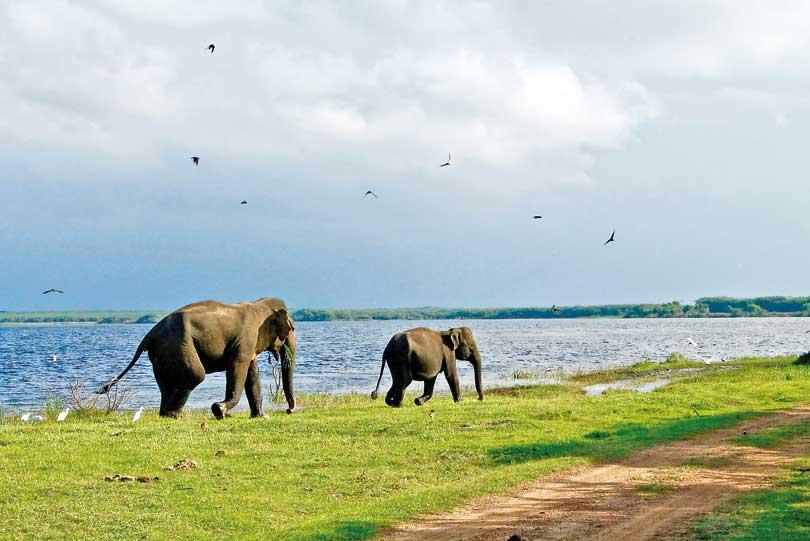Reply To:
Name - Reply Comment

 When seven elephants were found dead under suspicious circumstances in Habarana the country was shocked and the debate on the human-elephant conflict was renewed. Within hours, there were efforts to tagvillagers as having a hand in this horrendous act. Ostracizing villagers is a cruel case of irony while the elephant in the room - sinister forces of baby-elephant snatchers - go scot-free.
When seven elephants were found dead under suspicious circumstances in Habarana the country was shocked and the debate on the human-elephant conflict was renewed. Within hours, there were efforts to tagvillagers as having a hand in this horrendous act. Ostracizing villagers is a cruel case of irony while the elephant in the room - sinister forces of baby-elephant snatchers - go scot-free.
This incident also brings in to focus our long-term strategy on elephant-villager conflict management. Except for the Pinnawala experiment, present conservation programs have shown to be porous. Blaming the villager in this instance is like missing a milky-way-sized forest for a few sods.
This conflict is a binary issue as opposed to being conveniently labelled as an ex parte problem created by villagers. It’s a palindrome of sort: you get the same thing regardless from which side you look at it. The villager is an equal stakeholder and victim in this mess just like the elephant. But indeed, the villager bears the full brunt of the blame. We feel the government, conservationists, elephant lovers, tourism interests and culture gurus are ganging up on us with little care for our side of the story.
I am privy to the 2 a.m. mindset of a villager when a parade of elephants comes and knock on the fence of his small garden plot. He stays awake bearing witness to the damage elephants cause.
On other nights, the rumbling or hissing of this parade in the purlieu of the village is the continuation of his daily nightmarish anxiety. For these villagers who live in the shadow of nightly trepidation, this is what a living costs. However, regardless of how tense his wait for the danger to pass, the reluctance of this man to cause harm to this elephant family is as big as the elephant itself.
Here are some true stories of elephant-human bond dynamics that I am personally aware of. My brother rides the bike 8 km one-way daily through an elephant-infested corridor on Mahakanadarawa wewa ismatta to teach at Netiyagama school. How many days a mountain of an angry elephant, oozing musk and charged to the brim, stood staring irascibly at him blocking his path and ready to pounce in an instant? In the true story of Echoes of the Millstone (CreateSpace 2015), some 70 years ago in Mahakanadarawa jungle, still a park-like forest then, two grown-up villagers stumbled upon the body of the tusker they had felled the evening before. After seeing the majesty of the tusker even in death, the men got overwhelmed with guilt and shame of their crime. In shock, they squatted, covered their faces with the fold of the sarong and began to cry.
My mother told me a true story of a once in a lifetime elephant encounter. One day she placed her 6-month-old baby (me) on a pedura under a tree in her hena and moved 75 metres farther to till millet alone. The baby was cooing alone happily when unbeknownst to my mother, a baby elephant with its mother and cousins in tow quietly toddled in from the opposite end of the hena and stood over me, in a surreal moment of maternal fairytale magic but inherent realities villagers face on land they shared with elephants.Luckily for me, the elephant mother recognizing the mix-up her baby was creating nudged it away and left the hena without any fuss.
As perilous, poignant, and poetic as these stories are, they mirror how writ large entwined these two parties are. They are aninconvenience to each other but treat it as part of their existence inexorably inherited since the time before living memory.
I urge caution not to stereotype villager as being evil. We must discuss elephant deaths with an open mind. They appear to have just dropped dead. It’s a possibility that the herd stumbled upon a pumpkin patch that had been treated with a strong insecticide. But the absence of signs of struggle or trauma on the dead animals suggests a well-schemed operation - secretive, vicious, and not done on impulse.
The baby-elephant-napping mafia getting hold of this deadly agent and a sophisticated darting technique is not out of the realm of possibility. If there are lactating animals among dead, and their babies are unaccounted for, undoubtedly, a killing machine is on the loose!
Stealing baby elephants by evil forces is as old as our history. Kings have gifted villages and Disawanis (Dukedoms) to his subjects for their fealty when they presented a baby tusker to the Court. This baby sure could not have been escorted away from a mom-elephant’s cradle. In Pulse of the Jungle (Visvalekha 2000), a headman in late 1800s village in North Central Province kills the mother and steals the baby elephant to be shipped to an Indian Maharaja. In Sri Lanka now, such forces are happily engaged as seen from dozens of illegally acquired young elephants often discovered in the backyards of well-to-do people.

Numbers & Domestication
South Africa’s 1.2 million km 2 land area has 20,000 elephants (1 for every 65 km2) while Sri Lanka’s 65000 km2 of land holds 6000 elephants (1 for every 10 km2). Thailand’s 171000 km2 land area supports 6000 elephants. Half of them are tamed, whereas only about 4% of Sri Lankan elephants are domesticated. A study in 2002 found 80% of elephant habitat in Sri Lanka had ‘some form of human disturbance.’ This is an egregious wrong done to the struggles of elephants and villagers – two sides of the same coin struggling share space.
The 50% of the elephant population in Thailand is not at war with the villagers, thus guaranteed a full life. This maxim doesn’t apply to their Sri Lankan brethren as 96% of them are in the wild and are at the mercy of every vicious machination designed for their destruction. Yet, we cry foul seeing an elephant tied to a coconut tree in the back yard of a house or a temple but allow about 300 elephants to die unnatural deaths yearly (120 in 1996) and do little to stop the carnage.
No villager ever wants to hurt an elephant. No villager grabs the land away from an elephant. Villager treats the elephant as part of his environment. The cherubic and halcyon sight of a herd of elephants feeding on the wewa ismatta is villager’s precious gift and gilded birthright which the tourists and urbanites pay thousands to experience. Contrast this to a boxed or caged elephant in the zoo. It stands chained, crying in silent agony, bathed in its muck, and begging for food crumbs which only comes at set times.
No villager wants an elephant to go through such hell. The wild giants come to the purlieu of my village to do what they must do – move freely and find food. Only their large numbers have put a damper on their predicament.
In their tested wisdom, villagers impart a few good suggestions to address this duel injustice. Treat elephant killing as something akin to capital murder. Stop telling that villagers are encroaching into elephant habitats. This land is villagers’ just as elephants’. Only the villagers’ meagre and limited options of life leave them with no alternative but treat the shared land as the only hope.
Villagers are Alone
It is unimaginable to think that this problem can be resolved without the active participation of the villagers who feel they are sidelined. At present, decisions on the elephant problem are made on a unilateral basis restricting the affected villagers to the steerage class. For good reason, they are also frustrated because there is no representation for them on this issue.
Preemptive Chasers
A rotating team of villagers (salaried with incentives) can be set up in every village as preemptive chasers of elephants. This will make villagers the stakeholders of the problem. Remember how helpful Home Guard units were during the separatist war? The village trackers can look for stray elephants and take preemptive action to chase them away from the village. This kind of tracking is in villagers’ DNA. Tying a bell on every matriarch of a core of elephants will help this no doubt. The bell will alert the villagers when the elephants get closer. Thailanders tie a wood rattler (Sokade) around the elephant’s neck when they release it to the forest to forage. A radio collar as done in some cases is of no use!
Birth Control
Villagers believe why the authorities won’t revisit the policy of allowing elephants to propagate with abandon, a policy adopted following the drop of elephant population below 3000 in the 80s.
Elephant population increase is a double-edged sword. Because while they flirted freely, we Homo sapiens didn’t rest either. We accrued our progeny gleefully in greater numbers, pushing the carrying capacity of the land space to the edge. Unless we mimic a Port City-type solution, soon we will run out of the real estate for both parties.
Some African countries are forerunners in efforts to slow down elephant population growth with ways that are humane, logical, and sustainable. We spend millions to control human births for good reasons. Over-population in any species leads to sour consequences.
Domestication
There can be as much as 500 individuals or institutions (like temples) with renewed interest in wanting to adopt or own elephants. That is a 500 too many elephants that will not harass villagers and not die unnaturally.
Since elephant-powered work has disappeared, owning an elephant has become either a show of vestiges of ducal lineage or one’s new economic prowess.
It is no secret that a dust-covered tusker tethered in a corner of a private garden generates more ‘oohs’ and ‘aahs’ than the glitzy automobile parked on the owner’s front yard. For the villager, this is one more elephant safely removed from being a pest to his livelihood.
Tasmanian Effect
Villagers see elephant-human contacts taking a newer turn. Elephant’s dwindling land area is leading to more contacts not just with villagers, but the urbanites in more ways than we envisioned. The upgraded road system is full of vehicles now, and on every lonely bend on roads through elephant corridors, elephants are camped out waiting for offerings of fruit baskets from these vehicles.
Such unusual interaction coupled with more than normal trips across villages make future elephant generations to grow up/evolve thinking that begging for food is part of their life.
They lose fear in humans and forgetting their foraging instincts which anthropologists call Tasmanian Effect/Devolution – isolation from its evolved habits and practices as happened to hunter-gatherers in Tasmania when rising sea level isolated it as an island 8,000 years ago.
This rings ominously true as new ‘lifestyle’ of elephants makes it harder to separate the two species now on a collision course.